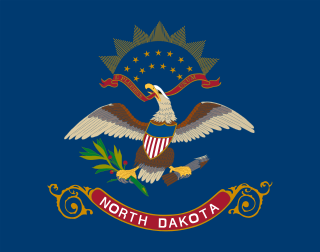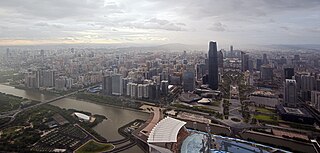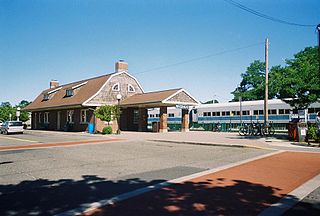Related Research Articles

North Dakota is a landlocked U.S. state in the Upper Midwest, named after the indigenous Dakota Sioux. It is bordered by the Canadian provinces of Saskatchewan and Manitoba to the north and by the U.S. states of Minnesota to the east, South Dakota to the south, and Montana to the west. North Dakota is part of the Great Plains region, characterized by broad prairies, steppe, temperate savanna, badlands, and farmland. North Dakota is the 19th largest state, but with a population of less than 780,000, it is the 4th least populous and 4th most sparsely populated. The state capital is Bismarck while the most populous city is Fargo, which accounts for nearly a fifth of the state's population; both cities are among the fastest-growing in the U.S., although half of all residents live in rural areas.

South Dakota is a landlocked state in the North Central region of the United States. It is also part of the Great Plains. South Dakota is named after the Dakota Sioux tribe, which comprises a large portion of the population with nine reservations currently in the state and has historically dominated the territory. South Dakota is the 17th largest by area, but the 5th least populous, and the 5th least densely populated of the 50 United States. Pierre is the state capital, and Sioux Falls, with a population of about 213,900, is South Dakota's most populous city. The state is bisected by the Missouri River, dividing South Dakota into two geographically and socially distinct halves, known to residents as "East River" and "West River". South Dakota is bordered by North Dakota to the north, Minnesota to the east, Iowa to the southeast, Nebraska to the south, Wyoming to the west, and Montana to the northwest.

Urbanization is the population shift from rural to urban areas, the corresponding decrease in the proportion of people living in rural areas, and the ways in which societies adapt to this change. It can also mean population growth in urban areas instead of rural ones. It is predominantly the process by which towns and cities are formed and become larger as more people begin living and working in central areas.

A ghetto is a part of a city in which members of a minority group are concentrated, especially as a result of political, social, legal, religious, environmental or economic pressure. Ghettos are often known for being more impoverished than other areas of the city. Versions of such restricted areas have been found across the world, each with their own names, classifications, and groupings of people.

Larimore is a city in Grand Forks County, North Dakota, United States. It is located three miles south of the junction of U.S. Route 2 and North Dakota Highway 18. Larimore is part of the "Grand Forks, ND-MN Metropolitan Statistical Area" or "Greater Grand Forks". The population was 1,260 at the 2020 census.

In general, a rural area or a countryside is a geographic area that is located outside towns and cities. Typical rural areas have a low population density and small settlements. Agricultural areas and areas with forestry are typically described as rural, as well as other areas lacking substantial development. Different countries have varying definitions of rural for statistical and administrative purposes.

Riverhead is a census-designated place (CDP) roughly corresponding to the hamlet by the same name located in the Town of Riverhead in Suffolk County, on Long Island, in New York, United States. The CDP's population was 13,299 at the 2010 census.

North Dakota was first settled by Native Americans several thousand years ago. The first Europeans explored the area in the 18th century establishing some limited trade with the natives.

The underclass is the segment of the population that occupies the lowest possible position in a class hierarchy, below the core body of the working class. This group is usually considered cut off from the rest of the society.
Urban decay is the sociological process by which a previously functioning city, or part of a city, falls into disrepair and decrepitude. There is no single process that leads to urban decay.

Harry Samuel Magdoff was a prominent American socialist commentator. He held several administrative positions in government during the presidency of Franklin D. Roosevelt and later became co-editor of the Marxist publication Monthly Review.

Loïc J. D. Wacquant is a French sociologist specializing in urban sociology, urban poverty, racial inequality, the body, social theory and ethnography.
Racial steering refers to the practice in which real estate brokers guide prospective home buyers towards or away from certain neighborhoods based on their race. The term is used in the context of de facto residential segregation in the United States, and is often divided into two broad classes of conduct:
- Advising customers to purchase homes in particular neighborhoods on the basis of race.
- Failing, on the basis of race, to show, or to inform buyers of homes that meet their specifications.

The history of African Americans in Chicago or Black Chicagoans dates back to Jean Baptiste Point du Sable's trading activities in the 1780s. Du Sable, the city's founder, was Haitian of African and French descent. Fugitive slaves and freedmen established the city's first black community in the 1840s. By the late 19th century, the first black person had been elected to office.

Poverty in India remains a major challenge despite overall reductions in the last several decades as its economy grows. According to an International Monetary Fund paper, extreme poverty, defined by the World Bank as living on US$1.9 or less in purchasing power parity (PPP) terms, in India was as low as 0.8% in 2019, and the country managed to keep it at that level in 2020 despite the unprecedented COVID-19 outbreak. According to the World Bank, India experienced a significant decline in the prevalence of extreme poverty from 22.5% in 2011 to 10.2% in 2019. A working paper of the bank said rural poverty declined from 26.3% in 2011 to 11.6% in 2019. The decline in urban areas was from 14.2% to 6.3% in the same period. The poverty level in rural and urban areas went down by 14.7 and 7.9 percentage points, respectively. According to United Nations Development Programme administrator Achim Steiner, India lifted 271 million people out of extreme poverty in a 10-year time period from 2005–2006 to 2015–2016. A 2020 study from the World Economic Forum found "Some 220 million Indians sustained on an expenditure level of less than Rs 32 / day—the poverty line for rural India—by the last headcount of the poor in India in 2013."
African-American neighborhoods or black neighborhoods are types of ethnic enclaves found in many cities in the United States. Generally, an African American neighborhood is one where the majority of the people who live there are African American. Some of the earliest African-American neighborhoods were in New Orleans, Mobile, Atlanta, and other cities throughout the American South, as well as in New York City. In 1830, there were 14,000 "Free negroes" living in New York City.

Slum tourism, poverty tourism, ghetto tourism or trauma tourism is a type of tourism that involves visiting impoverished areas, or in some cases, areas that were affected by disasters, such as nuclear fallout zones like Chernobyl or Fukushima. Originally focused on the slums and ghettos of London and Manhattan in the 19th century, slum tourism is now prominent in South Africa, India, Brazil, Kenya, Philippines and the United States.

Concentrated poverty concerns the spatial distribution of socio-economic deprivation, specifically focusing on the density of poor populations. Within the United States, common usage of the term concentrated poverty is observed in the fields of policy and scholarship referencing areas of "extreme" or "high-poverty." These are defined by the US census as areas where "40 percent of the tract population [lives] below the federal poverty threshold." A large body of literature argues that areas of concentrated poverty place additional burdens on poor families residing within them, burdens beyond what these families' individual circumstances would dictate. Research also indicates that areas of concentrated poverty can have effects beyond the neighborhood in question, affecting surrounding neighborhoods not classified as "high-poverty" and subsequently limiting their overall economic potential and social cohesion. Concentrated poverty is a global phenomenon, with prominent examples world-wide. Despite differing definitions, contributing factors, and overall effects, global concentrated poverty retains its central theme of spatial density. Multiple programs have attempted to ameliorate concentrated poverty and its effects within the United States, with varying degrees of progress and to sometimes detrimental effect.

The 2016 South Dakota Democratic presidential primary was held on June 7 in the U.S. state of South Dakota as one of the Democratic Party's primaries ahead of the 2016 presidential election.

Ghettos in the United States are typically urban neighborhoods perceived as being high in crime and poverty. The origins of these areas are specific to the United States and its laws, which created ghettos through both legislation and private efforts to segregate America for political, economic, social, and ideological reasons: de jure and de facto segregation. De facto segregation continues today in ways such as residential segregation and school segregation because of contemporary behavior and the historical legacy of de jure segregation.
References
- ↑ "Broken Heartland: The Rise of America's Rural Ghetto. - book reviews". Monthly Review. 1993. Archived from the original on 2006-05-30.
- ↑ "'A Hidden America: Children of the Mountains'". ABC News .